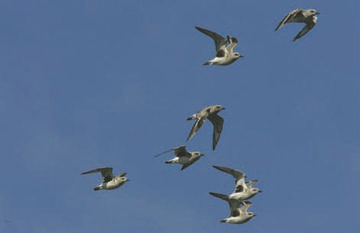Grey Plover (Pluvialis squatarola)

Grey Plover © Gary Bellingham
Grey Plovers migrate here from breeding grounds in the high Arctic, mostly the Taimyr Peninsula of Siberia, and in some winters there are probably now more of them in the county than there have ever been. Coward (1910) knew it as a spring and autumn passage migrant in the estuaries, with a few remaining for the winter, but gave no figures. Hardy (1941) provided useful quantitative information, quoting an average of five to ten birds, with the biggest flock 40. Bell’s statements were contradictory, writing ‘no apparent change since the beginning of the 20th century’ although clearly the numbers had increased: ‘flocks exceeding 100 are rare and in many years the maxima are much less, not usually reached until November or December’ (Bell 1962). Two unusually large flocks of c.150 were then found, at Red Rocks on 17 November 1962 and Leasowe shore on 16 February 1964 (Bell 1967). Numbers obviously grew rapidly, but unremarked by the annual county bird reports which contained no winter records until a flock of 300 at Parkgate on 12 January 1975 then a massive 1,700 on the Dee in December 1979, of which 1,550 were at Gayton Sands.
Most Grey Plovers winter in estuaries on the east coast of England, and it is probably no coincidence that many of these exceptionally large counts occur in severe weather when the sheltered west coast estuaries offer a temporary lifeline. When it freezes, this is the second most vulnerable wader species, after Redshank (Migration Atlas). The county’s largest ever flock, 2,620 on the Mersey on 17 February 1991, came when the east coast of Britain was frozen hard.
Perhaps because of this apparent sensitivity to the weather, the Dee estuary WeBS counts fluctuate greatly, often by a factor of two or three from one winter to the next. The Mersey seems to be a secondary site, with even larger variations in numbers, dropping from 2,100 in 1993/ 94 to only 60 birds in 2000/ 01. During this decade the Dee estuary high-tide WeBS counts have averaged around 1,000 birds, with about 200 on the Mersey estuary. Many more birds are found by low-tide feeding counts, however, implying that many birds must roost at sites that are not counted, with maxima of 2,201 at low tide on the Dee in 2001/ 02 and 597 on the Mersey in 2005/ 06. The current threshold for national importance is a five-year peak mean of 530 birds.
This winter Atlas map is a good representation of their normal distribution. Grey Plovers are seldom found in winter inland, away from tidal areas, with perhaps one or two birds a decade, usually at Sandbach Flashes, but none during the three years of this survey. They are birds of very restricted habitat. The 38 submitted habitat records comprised 23 H3 (estuarine), 5 H1 (open shore), 9 C9 (saltmarsh) and one C8 (‘other open marsh’), used to describe the dry area of the dredging deposit lagoon of no.6 bed at Frodsham Marsh. They feed, loosely scattered across a mudflat, on a variety of invertebrate prey, especially those that come to the surface or near to it; some birds defend feeding territories, and most of them feed as much at night as by day.
Sponsored by Tony and Margaret Hayter

